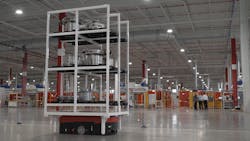Sometimes it's hard to remember that the digitalization of manufacturing has only been discussed in earnest for the past five years or so. With all the surrounding technological developments—from the Internet of Things to virtualization to augmented reality to edge computing—it seems like we’ve been talking about this for much longer. But most of the developments have really just come to the forefront in industry over the last three to four years.
What’s still missing are multiple reference points of digital implementations in industry. Although real-world examples have been popping up more regularly, they’ve been slow in coming—which is hardly surprising given the relative newness of the application concepts and some of the supporting technologies.
One of the more recent real-world examples that can now be referenced is automotive supplier Faurecia’s new $64 million, data-driven manufacturing facility in Columbus, Ind. The 400,000 sq ft facility, known as Columbus South, employs 450 people and produces a new, high-tech emissions control product for the commercial vehicle industry.
"This facility represents our entry into Industry 4.0, a revolutionary concept incorporating connectivity, automation, data processing and hardware to advance the manufacturing industry," said Mike Galarno, plant manager of Columbus South. "We are proud to be the first plant to incorporate many of these leading technologies under one roof to create efficient systems and an innovative working experience for employees."
The digital features of the Columbus South facility include:
* Use of collaborative robots in production.
* Quality management via laser scanning for early detection of variation.
* Self-learning autonomous intelligent vehicles (AIVs) to transport component parts to the assembly line. These vehicles will travel 73 miles making 17,300 pallet moves each day.
* Continuous data collection, which enables employees to predict and prevent equipment failures.
* A completely paperless environment keeping employees connected and informed with real-time information—an example of this includes the use of touch screen monitors for daily meetings. Instead of gathering around boards with updated papers, supervisors use iPads to connect to monitors to review information.
The data collection enabled by these technologies at Columbus South will amount to terabytes of data daily, requiring a full-time, on-site mathematician to continually mine data, cull insights and forecast an issue before it occurs.
“Data is being collected over a very sophisticated network system,” said Dave DeGraaf, president of Faurecia Emissions Control Technologies North America. “We have over 1.3 miles of fiber connecting all the machines in the plant to the network. Each network location has a redundant fiber uplink to the primary and a backup location, allowing up to 10 GB of data transfer, which is 10 times faster than normal. Within Columbus South, we have a total of 1,056 potential network drops, 60 wireless access points, and an extensive back-up system to reduce fail time.”
With 48 locations in Canada, Mexico and the U.S., Faurecia is one of the world's largest automotive equipment suppliers. The company provides automotive seating, interior systems and emissions control technologies. Faurecia sees its move toward digitalization as a high-profile industry example. “Manufacturing is sometimes stereotyped as dirty and requiring few skills,” said DeGraaf. “Columbus South contributes to the shifting landscape of the industry to one that is modern, clean and technologically advanced, and aimed at attracting a new generation of employees with different and advanced skillsets.”
About the Author
David Greenfield, editor in chief
Editor in Chief

Leaders relevant to this article:
